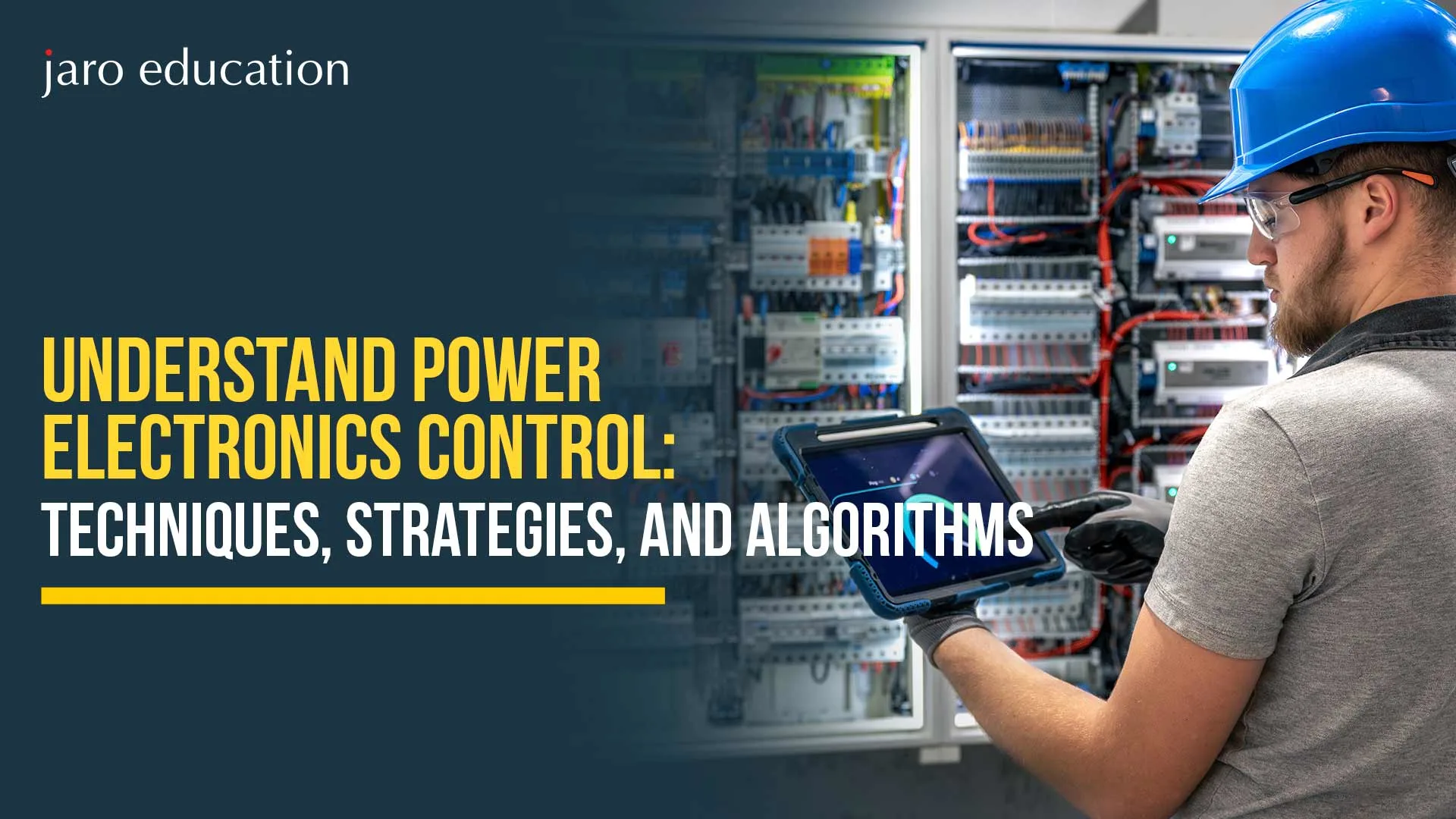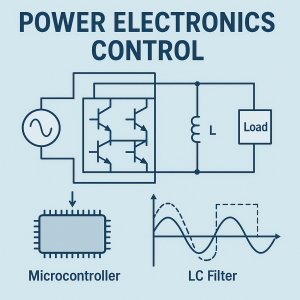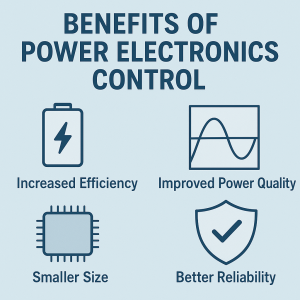
Understand Power Electronics Control: Techniques, Strategies, and Algorithms
In modern electrical systems, where effectiveness defines performance in terms of efficiency, precision, and reliability, understanding power electronics control has been considered essential in today's world of technology. With renewable energy systems, e-vehicles, and industrial automation, the role played by power electronics control has been ever-growing during this transition towards smarter, more sustainable solutions.
As devices become more sophisticated, engineers must acquire the art of interfacing between hardware and intelligent control systems, which intrinsically emanates from power electronics and control. This area dictates how converters, inverters, and drives shall behave under time-varying load conditions, voltage perturbations, switching frequencies, and system-level needs or requirements.
From pulse-width modulation techniques to digital control algorithms, the evolution of power electronics has opened up new avenues toward optimization and stability. Such technological advances guarantee smoother energy flow, reduced losses, and increased system reliability in various applications.
In this blog, foundational concepts, advanced strategies, and real-world algorithms will be discussed that define the future of power electronics control. Grasping these advanced techniques will provide insight into how to design and troubleshoot efficient, intelligent, high-performance power systems.
Table Of Content
Techniques/ Strategies of Power Electronics Control
Applications of Power Electronics Control
Algorithms of Power Electronics Control
Benefits of Power Electronics Control
What is the future of Power Electronics Control?
Final Thoughts
Frequently Asked Questions
Techniques/ Strategies of Power Electronics Control
Time Ratio Control
In time ratio control, the constant (k) is known as the duty ratio. There are two ways to achieve time ratio control.
- Constant frequency
- Variable frequency
In the constant frequency control method, the frequency remains constant while T, the ON time, is kept varied. This power electronics control technique is called pulse width modulation.
In the variable frequency control method, the ON time (T) is kept constant while the frequency varies. This power electronics control technique is called frequency modulation control.
Current Limit Control
In a converter (DC to DC), the value of the current varies between the minimum and the maximum levels for continuous voltage. In this method, the chopper is first switched ON and then OFF to check that the current is kept constant between both upper and lower limits. When the current is travelled beyond the maximum levels, the chopper goes OFF. When the switch is at an OFF mode, current flows through the diode and diminishes exponentially. When the current falls below a certain threshold, the chopper is ON again. This technique can be used either when the frequency is kept constant or when the ON time t is constant.
Applications of Power Electronics Control

1. Electric Transportation
Power electronics control methods are used in electronic vehicles to handle the charging and removal of the battery, manage the electric motor and regulate the power flow in the vehicle.
2. Power distribution and transmission
It is used to manage voltage levels, increase system efficiency, and avoid power losses in power distribution and transmission systems.
3. Renewable energy integration
Solar panels, wind turbines and other renewable energy sources require power electronics to transform produced electricity into usable AC power that can be incorporated into the power grid.
4. Energy storage
Power electronics control is employed in energy storage devices like batteries and flywheels to manage loading and discharging, ensuring efficient and consistent power conversion.
5. Lightning and Control
This mechanism is used in lightning and lightning control systems to adjust voltage levels, manage power supplies and control brightness (of lights).
6. Consumer Electronics
It is used in consumer electronic products like televisions, smartphones and computers to regulate voltage levels and manage power supplies.
7. Medical Equipment
Power electronics control is used to optimise system performance, manage power supplies and regulate voltage levels of medical equipment, such as life-supporting systems and therapeutic devices.
8. Industrial drives and control systems
It is used in industrial drives and control systems to regulate power supply, manage the speed and torque of electric motors, and improve the performance of systems.
Algorithms of Power Electronics Control
Formal techniques can be used at an early stage of system development, such as the specification stage. The most valuable formal methods are symbolic model checking and statistical model checking, both of which are currently being applied to a wide range of systems, including production systems, cyber-physical systems, and instrumentation and control systems. Their application in power electronic systems is a research topic that has lately piqued the interest of international research institutions.
Benefits of Power Electronics Control

1. Compact Design
The devices run by power electronics are lighter and smaller than traditional electrical systems, ensuring more compact and smooth designs in electrical systems.
2. Cost savings
By increasing system efficiency and reducing energy consumption, power electronics can reduce the cost of maintenance and repairs.
3. Versatility
This mechanism can be used in a wide range of applications, from renewable energy components to electric vehicles as well as consumer electronics.
4. Energy Efficiency
Power electronics increase energy efficiency by converting alternating current to direct current with minimal losses and controlling voltage levels to fit the load’s requirements.
5. High-speed switching
It has high-speed switching, which allows for quick and efficient regulation of the electrical power flow.
6. Improved control
Power electronic control improves control over the flow of electrical power by allowing for exact regulation of power quality standards, current and voltage.
7. Increased safety
Power electronics enhance safety by avoiding electrical risks and protecting electrical components from harm.
8. Increased reliability
It improves dependability by delivering steady and constant power conversion and reducing over-current, over-voltage, and over-temperature damage to electrical components.
What is the future of Power Electronics Control?
1. Smart Grid Technology
Smart grid technology development is projected to play a major role in the future of power electronics. Power elects will be utilised to control power flow and assure stability and dependability, enabling more efficient and effective energy management.
2. AI and Machine Learning
Artificial intelligence and machine learning integration into power electronics are projected to play a key role in the future. This will enable real-time monitoring and control of power electronic systems, resulting in increased efficiency and dependability.
3. Increased Adoption of Renewable Energy
Renewable energy sources, such as solar panels and wind turbines, are likely to gain popularity in the coming years. Power electronics will be critical in allowing renewable energy to be integrated into the electrical system.
4. Electric Vehicle
The expansion of the electric car sector is likely to increase demand for power electronics significantly. The charging and discharging of electric car batteries will be controlled by power electronics, providing efficient and dependable energy management.
Final Thoughts
The multi-disciplinary study of power electronics control encompasses different techniques, strategies, and algorithms. It is used in a wide range of applications and is expected to have a brighter future with regard to electric vehicles and energy-storage medical equipment.
If electrical engineering is your field of interest, then you can participate in the Advanced Programme in Electric Vehicle Technology Programme offered by CEP, IIT Delhi. You will be getting a top-tier facility for the course that would help you with real-life case studies. The power electronics control IIT Delhi course will also feature hands-on exercises and assessments and industry-relevant project work, ensuring amplified growth in your career.
Frequently Asked Questions

